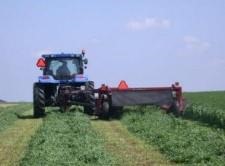By Mark Sulc and Bill Weiss
The optimal time for making a first cutting of forages is fast approaching. But what is the optimal timing to take the first cutting (or any cutting for that matter)? Many will answer by saying it is when you have time and there is a good weather window to get the forage cut and put up! Yes indeed, that is a valid answer. Both of those factors are important and can’t be ignored. However, we know that forage quality declines as the crop moves into flowering stages. The first cutting is usually the highest yielding cutting, so we should try to aim for good quality for as much of it as possible!

Timing is everything!
But what is “good quality” forage? The correct answer is that it depends on what you feed it to. The concentration of neutral detergent fiber (NDF) is a measure of most of the fiber in forages. The concentration of forage fiber increases with maturity and is negatively correlated with feed intake by animals and the energy concentration of the diet. With hay crop forages, digestibility of the fiber and NDF concentrations have a strong negative correlation so one can assume forages with greater NDF concentrations have fiber that is less digestible.
Below are good forage NDF targets to aim for when feeding different classes of livestock (Table 1). These are general guidelines, but forage within these NDF ranges should provide good animal performance in properly balanced diets.
Table 1. Optimal ranges for forage neutral detergent fiber (%NDF) for different classes of livestock.
Forage type | Dairy cows:
high producing & early lactating | Dairy cows: average producing (<27,000 RHA1) | Beef cows: Gestating | Beef cows: lactating | Horses |
Legumes | 35 – 40% | 38 – 45% | 50% | 45% | 42 – 46% |
Grasses | 48 – 53% | 50 – 55 % | 60% | 55% | 55 – 60% |
Grass/legume mixture | 42 – 46% | 46 – 50% | 52 – 56% | 47 – 51% | 48 – 52% |
1 RHA = rolling herd average, calculated as the total pounds of milk produced in the last 365 days for the average cow in the herd.
So how do these targets help us with harvest timing? How do we know when the forage growing in the field is approaching these targets? Many factors affect forage quality, but we can make some educated estimates. An article published last week in this newsletter explains how to estimate alfalfa NDF in the field and we are tracking alfalfa NDF in fields across Ohio each week for the month of May (see this week’s article for updated estimates of alfalfa NDF).
The lower value of the NDF ranges in Table 1 should be the latest starting point to begin harvest, weather permitting, because the cutting, field curing, and harvesting process always results in higher NDF values than what the NDF value of the forage was at the time of cutting. Because forage quality changes so fast it is better to start too early than a little too late.
Grasses mature quickly and the optimal harvest window can be only a few days. In general, for high quality grass forage (50 – 55% NDF) suitable for lactating cows, the first harvest should be taken in late vegetative (pre-boot to very early boot stage) in the spring. The grass stem will have one to two palpable nodes (you can feel and see them on the lower stem) and no flowers have emerged. As soon as you see flowering heads emerging in the grass, the NDF is most likely just over 55%. As harvest is delayed, the NDF levels will quickly increase to 60% or higher. Maturity of the grass has a much bigger effect on forage NDF level than does grass species.
For subsequent harvests after the first, alfalfa can be harvested in the bud to early bloom stage (about every 30 days) for excellent quality. Bud stage alfalfa will usually contain 22% or higher crude protein (CP) and 40% NDF, while early bloom alfalfa will average 20% CP and 40 to 45% NDF. However, protein and NDF are not strongly correlated; often CP concentrations will be much higher or lower than these values. A good compromise to extend stand life of alfalfa in a dairy operation is to harvest at least one cutting during the summer months in the early bloom stage. The first two cuttings should be taken near 40% NDF, and later summer cuttings can be taken in the early bloom stage. The NDF content of alfalfa declines more rapidly with maturity early in the season, so the late summer harvests can be made at a later maturity stage without as great a penalty on forage quality. The PEAQ estimation procedure for alfalfa NDF works well in all cuttings and for all types of alfalfa, including reduced lignin varieties. But reduced lignin varieties will have slightly higher fiber digestibility than standard varieties across all levels of NDF concentration. So reduced lignin varieties can offer a wider harvest window to achieve acceptable fiber digestibility when compared with standard alfalfa varieties.
For high quality pure grass stands, subsequent cuttings of grasses after the first harvest should be taken every 24 to 28 days, depending on location. For example, in northeastern Ohio, cutting intervals of about 28 days have provided forage of adequate quality for lactating cows. Delayed cutting beyond these intervals greatly reduces nutritional value of grass forage. Such cutting intervals are challenging, and that is why grass-legume mixtures should be considered if higher quality forage is needed. Legume-grass mixtures provide a much wider harvest window for good to high quality forage as compared with pure grass stands.
My hope is that this article helps you be alert and prepared to cut forages in a timely manner, and that the weather cooperates for a successful harvesting season this year!
Source : osu.edu